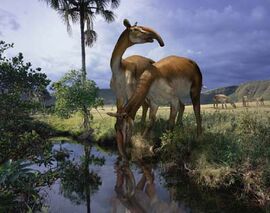No edit summary Tag: rte-wysiwyg |
No edit summary Tag: rte-wysiwyg |
||
| Line 21: | Line 21: | ||
*[[Paranthropus boisei]] |
*[[Paranthropus boisei]] |
||
*[[Gigantopithecus]] |
*[[Gigantopithecus]] |
||
| + | *[[Ancylotherium]] |
||
| − | * |
||
| − | [[ |
+ | *[[Deinotherium]] |
| − | * |
||
| − | [[Deinotherium]] |
||
[[Category:Geological history]] |
[[Category:Geological history]] |
||
[[Category:Article stubs]] |
[[Category:Article stubs]] |
||
Revision as of 12:27, 2 April 2015
| Pliocene | |||||||||||
|---|---|---|---|---|---|---|---|---|---|---|---|

| |||||||||||
| Previous period Miocene |
Following period Pleistocene | ||||||||||
The Pliocene or the Pliocene epoch is the second epoch of the Neogene, located between Miocene and Pleistocene. It began about 9.3 million years ago and ended 2 million years ago, lasting for about 7 million years.
During the Pliocene the northern hemisphere experienced a gradual change of the climate that became increasingly dry and cool. In the southern hemisphere, Antarctic ice continued to grow.
The Pliocene plants became more cold tolerant, open spaces increased (Next of Kin). Pliocene animals (also see below) includes the direct ancestors of modern horses, elephants, rhinoceroses, hoofed animals (Blood Brothers), etc. As shown by both Walking with Beasts and Walking with Cavemen, this was the time when the more advances species of Australopithecus began to evolve into human ancestors in Africa. Other animals living in Africa alongside Australopithecus include the highly aggressive elephant-like Deinotherium, the early sabre-tooth cat Dinofelis and the gentle herbivores like Ancylotherium.
About 2.5 million years ago, the continent of South America collided with North America, causing the Great Faunal Interchange. Placental mammals like Smilodon moved to the south, while the South American endemics, like Doedicurus and the terror birds moved to the north.
